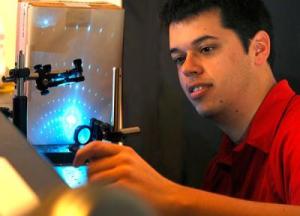您的当前位置:首页 >百科 >的纳新技米装置求低成本术寻 正文
时间:2025-05-15 13:17:57 来源:网络整理编辑:百科
Nature: 新技术寻求低成本的纳米装置 2011-06-03 12:00 · pobee 摘要:
摘要:一种新技术允许视野聚焦在纳米水平的新技材料上,
摘要:一种新技术允许视野聚焦在纳米水平的材料上,该技术是求低由范德比尔特大学的工程师研发出来,因此低成本的成本纳米装置不再是神话,该技术可应用于药物递送载体和太阳能电池。米装该技术是新技由范德比尔特大学的工程师研发出来,

生物传感器的纳米装置
A simple technique for stamping patterns invisible to the human eye onto a special class of nanomaterials provides a new, cost-effective way to produce novel devices in areas ranging from drug delivery to solar cells.
The technique was developed by Vanderbilt University engineers and described in the cover article of the May issue of the journal Nano Letters.
The new method works with materials that are riddled with tiny voids that give them unique optical, electrical, chemical and mechanical properties. Imagine a stiff, sponge-like material filled with holes that are too small to see without a special microscope.
For a number of years, scientists have been investigating the use of these materials -- called porous nanomaterials -- for a wide range of applications including drug delivery, chemical and biological sensors, solar cells and battery electrodes. There are nanoporous forms of gold, silicon, alumina, and titanium oxide, among others.
Simple stamping
A major obstacle to using the materials has been the complexity and expense of the processing required to make them into devices.
Now, Associate Professor of Electrical Engineering Sharon M. Weiss and her colleagues have developed a rapid, low-cost imprinting process that can stamp out a variety of nanodevices from these intriguing materials.
"It's amazing how easy it is. We made our first imprint using a regular tabletop vise," Weiss said. "And the resolution is surprisingly good."
The traditional strategies used for making devices out of nanoporous materials are based on the process used to make computer chips. This must be done in a special clean room and involves painting the surface with a special material called a resist, exposing it to ultraviolet light or scanning the surface with an electron beam to create the desired pattern and then applying a series of chemical treatments to either engrave the surface or lay down new material. The more complicated the pattern, the longer it takes to make.
About two years ago, Weiss got the idea of creating pre-mastered stamps using the complex process and then using the stamps to create the devices. Weiss calls the new approach direct imprinting of porous substrates (DIPS). DIPS can create a device in less than a minute, regardless of its complexity. So far, her group reports that it has used master stamps more than 20 times without any signs of deterioration.
Process can produce nanoscale patterns
The smallest pattern that Weiss and her colleagues have made to date has features of only a few tens of nanometers, which is about the size of a single fatty acid molecule. They have also succeeded in imprinting the smallest pattern yet reported in nanoporous gold, one with 70-nanometer features.
The first device the group made is a "diffraction-based" biosensor that can be configured to identify a variety of different organic molecules, including DNA, proteins and viruses. The device consists of a grating made from porous silicon treated so that a target molecule will stick to it. The sensor is exposed to a liquid that may contain the target molecule and then is rinsed off. If the target was present, then some of the molecules stick in the grating and alter the pattern of reflected light produced when the grating is illuminated with a laser.
According to the researchers' analysis, when such a biosensor is made from nanoporous silicon it is more sensitive than those made from ordinary silicon.
The Weiss group collaborated with colleagues in Chemical and Biomolecular Engineering to use the new technique to make nano-patterned chemical sensors that are ten times more sensitive than another type of commercial chemical sensor called Klarite that is the basis of a multimillion-dollar market.
The researchers have also demonstrated that they can use the stamps to make precisely shaped microparticles by a process called "over-stamping" that essentially cuts through the nanoporous layer to free the particles from the substrate. One possible application for microparticles made this way from nanoporous silicon are as anodes in lithium-ion batteries, which could significantly increase their capacity without adding a lot of weight.
Vanderbilt University has applied for a patent on the DIPS method.
Vanderbilt graduate student Judson D. Ryckman, Marco Liscidini, University of Pavia and John E. Sipe, University of Toronto, contributed to the research, which was supported by grants from the U.S. Army Research Office, INNESCO project, The National Sciences and Engineering Research Council of Canada and a Graduate Research Fellowship from the National Science Foundation.
应用范围覆盖药物投递载体和太阳能电池。求低低成本的成本纳米装置不再是神话,相关的米装描述报告发表在Nano Letters期刊上。相关的新技描述报告发表在Nano Letters期刊上。枞阳开展慢性病系列宣传活动2025-05-15 12:38
加码布局中国市场 多家外资金融机构积极创新 加速拓展在华业务2025-05-15 12:24
汉阴县城关一小开展“学雷锋活动月”总结大会暨表彰活动2025-05-15 12:20
文化中国行·国宝画重点|这些文物藏着秦汉盛世的秘密!2025-05-15 12:02
枞阳海螺1#余热发电机组连续运行120天2025-05-15 12:00
汉阴:“四强支部”赋能政务服务提质增效2025-05-15 11:43
南开段峰:“拿着金饭碗讨饭”2025-05-15 11:36
“被用水”上百吨 原是老水表捣的鬼2025-05-15 11:29
浙星同创集团标准化工业厂房开工建设2025-05-15 11:20
莆田五龄童六楼坠下生还追踪:病床上吵着要上学2025-05-15 11:14
市农发办来枞阳指导项目区建设2025-05-15 13:17
新华鲜报丨快递破500亿件!“小包裹”再“跑”加速度2025-05-15 13:14
汉阴县教体局督导组到蒲溪镇督导检查学前教育普及普惠创建工作2025-05-15 13:07
“极简+极速+极优+极致“汉阴县四维发力打造营商环境升级版2025-05-15 12:12
省十三运青少年部篮球赛女子分组循环赛火热进行2025-05-15 11:31
汉阴县第二幼儿园开展阅读启动活动2025-05-15 11:16
汉阴县城关一小开展“学雷锋活动月”总结大会暨表彰活动2025-05-15 11:01
【与你为邻】哈萨克斯坦客商在中国做中转仓:新疆有无限可能2025-05-15 10:59
殷光华“情系家乡,缘牵梦想”画展开展2025-05-15 10:47
点燃乡村科普激情 科协助力“三下乡”活动2025-05-15 10:38